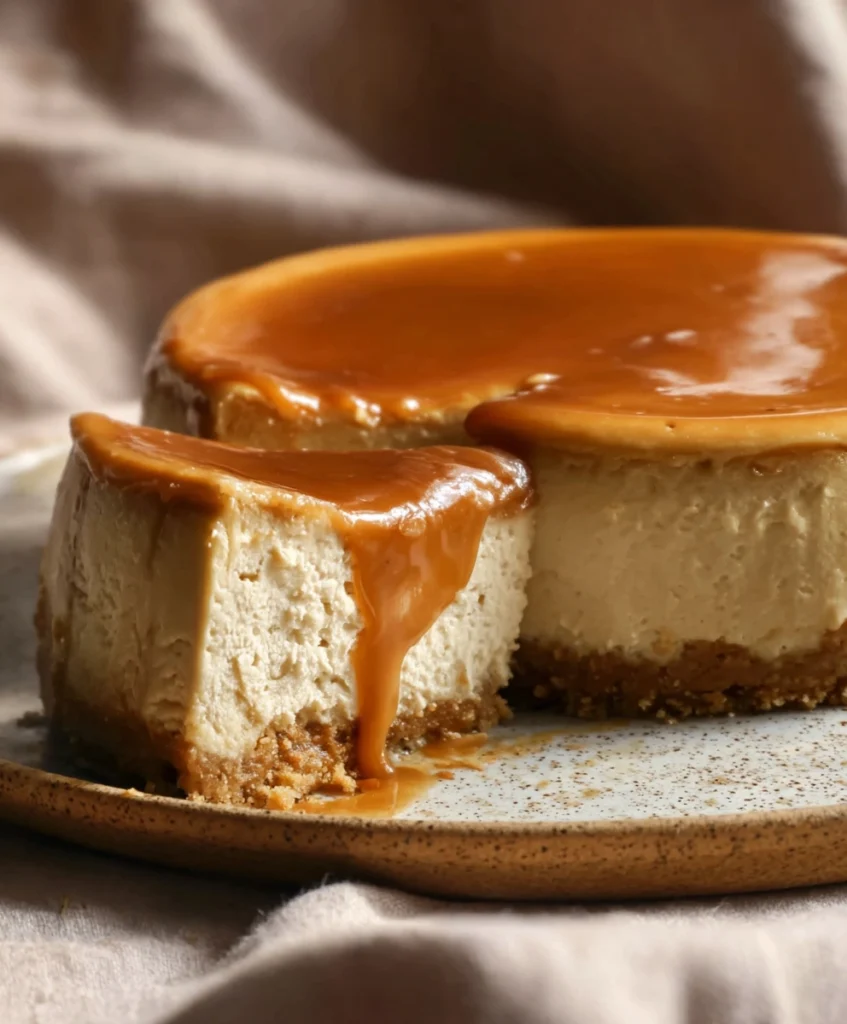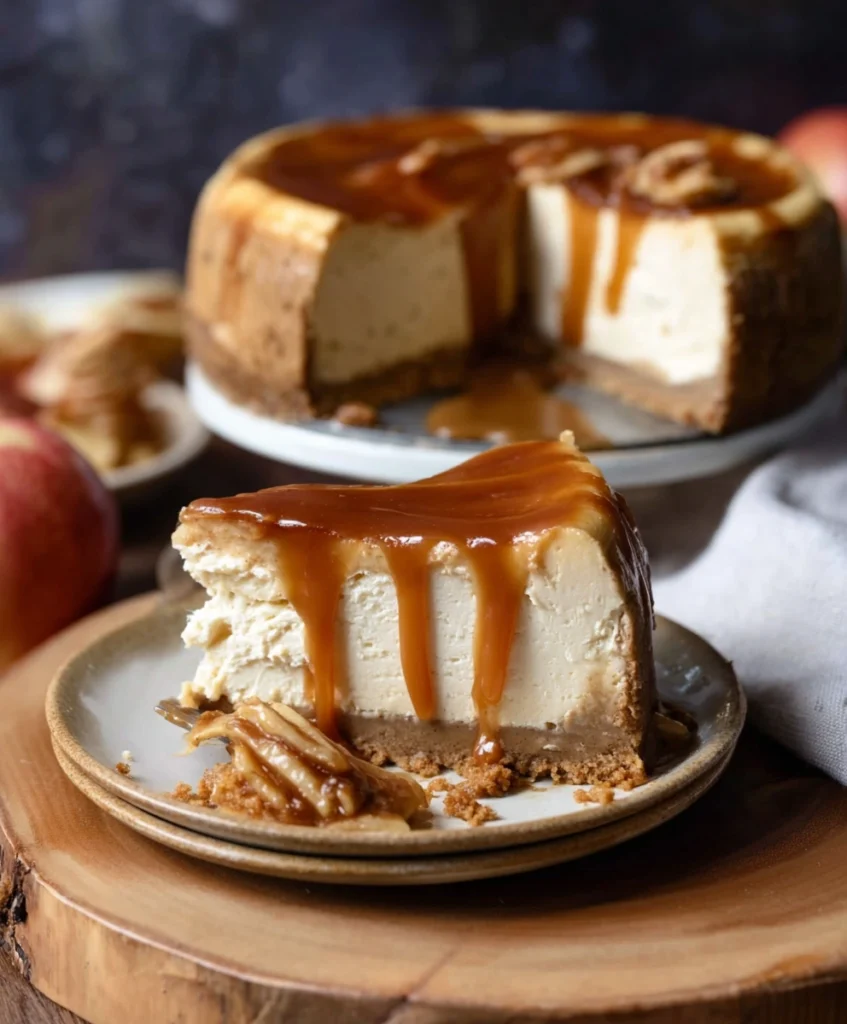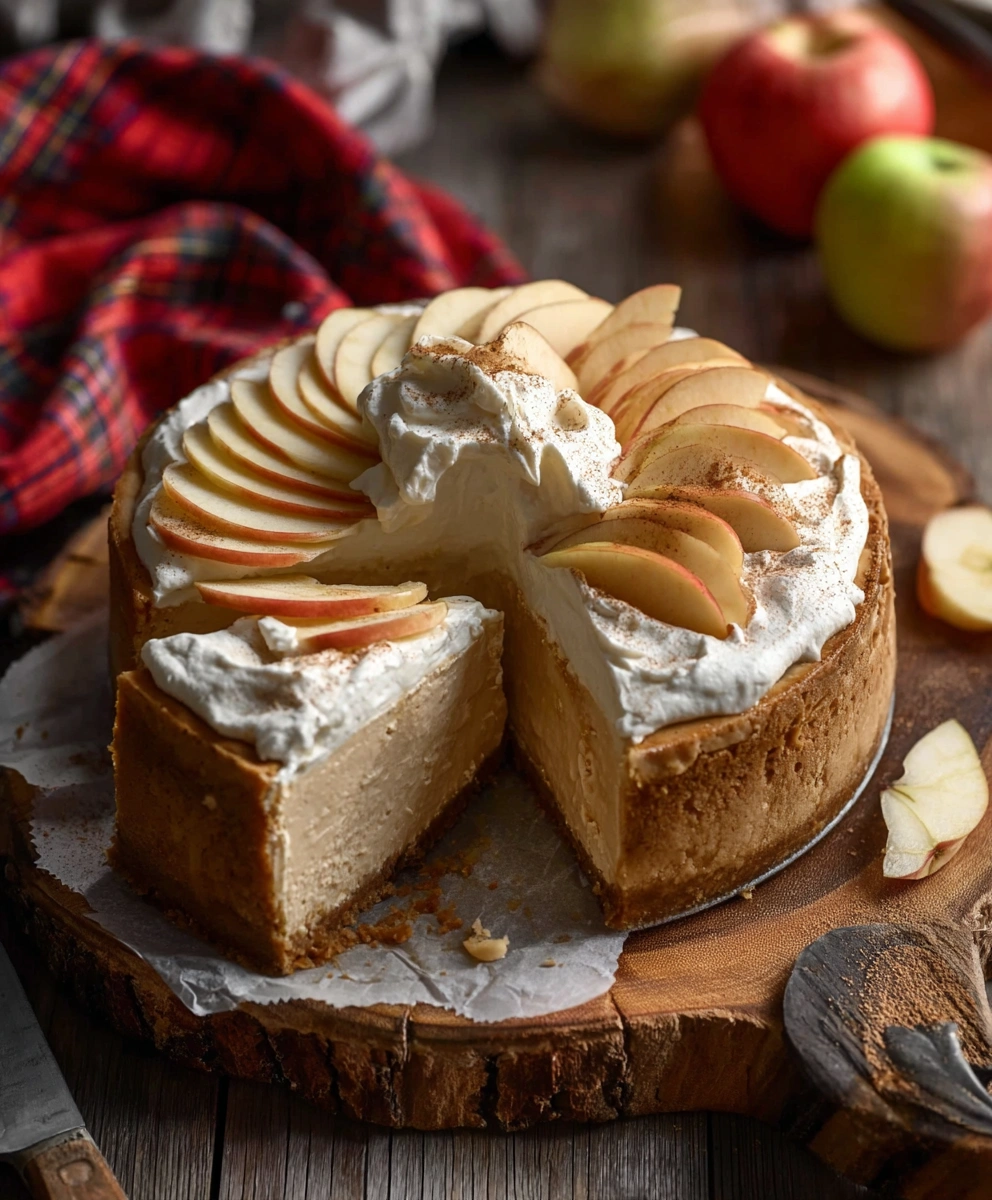If you’re looking for a fall dessert that feels fresh, seasonal, and indulgent — but isn’t the usual pumpkin fare — this Apple Cider Cheesecake is your answer. This version uses reduced fresh apple cider to infuse the cheesecake with a tangy, tart apple flavor. The texture is rich, creamy, and surprisingly light thanks to sour cream and a gentle baking method.
Why You’ll Love This Apple Cider Cheesecake
- Seasonal but unexpected — Apple cider is used instead of pumpkin, giving it a crisp, fruity punch.
- Creamy yet stable — The sour cream and a dash of flour help the cheesecake set well without being heavy or dense.
- Water bath baking without fuss — The recipe uses steam to avoid cracks without fully submerging the pan.
- Flexible toppings — From apple cider caramel to whipped cream or fresh apples, you can customize how you present it.

Ingredients & Measurements
Crust
- 2 cups digestive cookies or graham crackers, finely crushed
- ½ cup unsalted butter, melted
- ¼ teaspoon salt
- 2 tablespoons powdered sugar
Filling
- 3 cups fresh apple cider
- Mulling spices (optional, to flavor the cider while reducing)
- 3 bricks cream cheese, softened and at room temperature
- 1 cup brown sugar
- ½ teaspoon fine salt
- 2 teaspoons pure vanilla extract
- 1 cup full-fat sour cream
- ⅓ cup reduced apple cider (from the boiled portion)
- 1 teaspoon ground cinnamon
- 3 large eggs at room temperature
- 2 tablespoons all-purpose flour
Step‑by‑Step Instructions
- Reduce the Cider
Pour 3 cups fresh apple cider into a large saucepan. Add mulling spices if using. Bring to a boil over medium-high heat, then simmer until it’s reduced to a thick syrup (about 30–45 minutes). You’ll need about ⅓ cup of this reduced cider for the cheesecake. Let it cool. - Preheat & Prep Pan
Preheat your oven to 350°F. Grease a cake pan (preferably with 3-inch height) and line with parchment if desired. If using a springform pan, wrap it well to prevent water leaks during baking. - Make the Crust
In a food processor or by hand: crush cookies into fine crumbs. Add melted butter, salt, and powdered sugar. Mix until crumbs resemble wet sand. Press the mixture into the bottom (and optionally up the sides) of your prepared pan. Bake for about 10 minutes. Let it cool and chill slightly. - Lower Oven Temperature
Reduce oven to 325°F before baking the filling. - Mix the Filling
In a stand mixer or with a hand mixer: Beat cream cheese and brown sugar until smooth and lump-free, scraping down the sides as needed.
Add sour cream, vanilla, salt, cinnamon, and the cooled reduced cider. Mix until fully combined.
Add eggs one at a time, mixing just until each is incorporated. Avoid overmixing.
Add flour and gently fold or mix just to combine. - Bake with Steam
Place your cheesecake pan inside a larger baking dish or roasting pan. Pour hot water around it to create steam.
Pour the filling into the crust. Bake for about 1 hour 20–30 minutes, until the edges are set and the center slightly jiggles. - Cool Gradually
Turn off the oven and prop the door open. Let the cheesecake cool inside for 30 minutes. Then close the door and cool for another 15 minutes. Remove from the oven and let it cool fully on the counter. Refrigerate for at least 8 hours, preferably overnight.

Topping Ideas & Serving Suggestions
- Apple Cider Caramel — Drizzle this over the top just before serving.
- Stabilized Cinnamon Whipped Cream — Whip 2 cups heavy cream with 3–4 tablespoons powdered sugar, a pinch of salt, 1 teaspoon vanilla extract, and 1 teaspoon ground cinnamon until stiff peaks form.
- Fresh Apples — Slice apples and macerate them in lemon juice, sugar, and a pinch of salt. Add just before serving to keep the cheesecake fresh and bright.
You could also top the cheesecake with spiced apple compote or glazed apple slices using the leftover cider syrup.
Tips & Troubleshooting
- Use room-temperature cream cheese, sour cream, and eggs to avoid lumps and cracks.
- Wrap springform pans well to prevent water from seeping in during baking.
- Don’t rush the cooling — the gradual drop in temperature helps avoid cracks and sinking.
- The cheesecake can be made 1–2 days in advance and stored in the fridge.
- You can reduce the apple cider the day before and refrigerate it.
- If baking in a smaller, taller pan, adjust the baking time accordingly and test doneness with a gentle jiggle.
Why This Recipe Works
- The reduced cider syrup concentrates the apple flavor without thinning the batter.
- Sour cream contributes a rich, creamy texture while balancing sweetness.
- A small amount of flour gives the cheesecake structure without making it heavy.
- Steam baking ensures a moist environment to prevent cracking.

